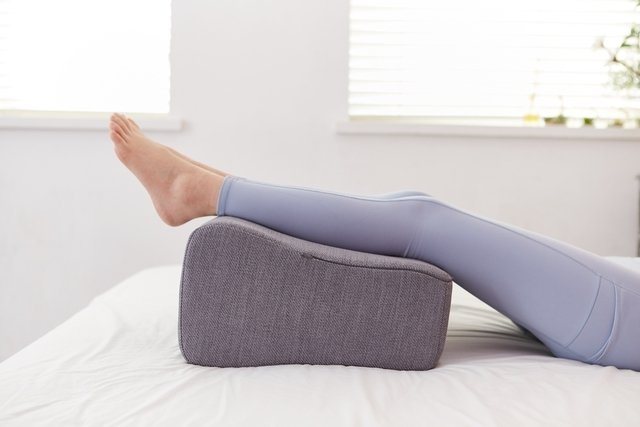Some ways to reduce leg swelling are to elevate your legs at the end of the day, drink plenty of fluids throughout the day, reduce salt intake and practice physical activity regularly, for example, or do exercises to de-swell your legs, as help improve blood circulation, return blood to the heart and increase fluid elimination.
Swelling in the legs is a very uncomfortable situation that can cause difficulty in moving the legs. It may arise due to poor circulation due to the body’s natural aging process, but it can also occur during pregnancy, long trips or due to illnesses, such as peripheral artery, diabetes, obesity or smoking, for example.
It is important to consult your general practitioner or angiologist if the swelling in your legs does not subside within 3 to 5 days so that the cause can be identified and the most appropriate treatment can be initiated. Furthermore, if you experience swelling in just one leg, pain, redness or heat in the area, you should go to the hospital immediately, as this could be a sign of deep vein thrombosis. Know how to identify the symptoms of deep vein thrombosis.
Top tips for de-puffing your legs
Some tips to help reduce leg swelling are:
1. Elevate your legs
Elevating your legs every day, especially at the end of the day, helps to relieve leg swelling because it promotes blood circulation and the lymphatic system, so that the blood accumulated in the legs returns to circulate normally throughout the body.
Therefore, it is recommended that the legs be elevated for around 10 to 20 minutes, and the person can lie on the floor and lift their legs, leaving them resting on the wall, or elevate them with the help of cushions or pillows, for example.
2. Drink plenty of fluids throughout the day
Drinking at least 2 liters of water, juices or diuretic teas during the day also helps to reduce leg swelling, as they help eliminate excess fluid and toxins accumulated in the body.
Thus, one option is to drink a glass of warm water with lemon juice and ginger before breakfast, because ginger promotes an increase in the amount of urine produced throughout the day, reducing the amount of liquid accumulated in the circulatory system and relieving swelling. Check out other tea options to relieve leg swelling.
3. Decrease the amount of salt
Excessive salt consumption during the day can favor the accumulation of fluids in the body, which can result in swelling of the legs. Therefore, by reducing salt consumption, it is possible to prevent your legs from becoming swollen.
An option to replace the salt normally used to season meals is aromatic herb salt, which in addition to seasoning food can bring several other health benefits, such as improving circulation and reducing fluid retention.
See the following video on how to prepare herb salt:
4. Practice physical activity
Practicing physical activities frequently can also help relieve leg swelling, as through exercise it is possible to improve blood and lymphatic circulation, preventing the accumulation of fluids in the body, especially in the legs.
Therefore, it is important that the person practices walking, running, dancing and/or strength exercises regularly and in accordance with the guidance of the physical education professional, as this makes it possible to reduce leg swelling more effectively.
5. Get massages
Leg massage is also a good option to relieve swelling, and is recommended at the end of the day. The massage must be done in the direction of the body, that is, the person must press the calf close to the foot and then, keeping it pressed, slide the hand towards the knee. This way, it is possible to activate blood and lymphatic circulation and help reduce swelling.
6. Use of medicines
When swelling in the legs does not improve with home measures such as elevating the legs, reducing the amount of salt consumed and increasing the consumption of water and diuretic teas, the doctor may recommend the use of some medications that can improve blood and lymphatic circulation and, thus, relieve swollen legs.
The medicine recommended by the doctor may vary according to the cause of leg swelling, and the use of diuretics or anticoagulants may be indicated. Find out the main causes of leg swelling and what to do.
Check out the video below for other tips to combat swollen legs:
Exercises to de-puff your legs
Exercises to de-swell the legs help improve blood circulation and venous return, relieving swelling in the legs.
Some exercise options to de-puff your legs are:
1. Move your feet
Moving your feet and ankles helps improve blood and lymphatic circulation, reducing or preventing the appearance of swelling in your legs.
How to make: Whenever possible, you can do foot exercises such as bending and stretching your feet up and down at least 30 times, or rotating each foot in a circle 8 times to one side and 8 times to the other. Additionally, you can flex and extend your toes for about 30 seconds, as it also helps improve blood circulation.
2. Calf stretch
The calf, or calf, is the muscle at the back of the leg, and is considered a second heart, as it helps pump blood from the legs towards the heart.
In this way, stretching or moving the calf helps prevent or reduce swelling in the legs.
How to make: lean against a wall or the back of a chair. With your spine straight and your abdomen contracted, stand on your toes and return to the starting position. Do 12 to 20 movements.
Another option, for people whose work requires standing for a long time, can flex their knees and ankles every hour or lift their body with their toes to help their calves pump blood from their legs. to the heart, reducing swelling in the legs.
In the case of jobs that require the person to sit for prolonged periods, they should get up and walk a little, within the company every 60 minutes or walk a block at lunch time, for example, or even in a sitting position, move the calf by raising the toes and then touching the heel to the floor, at least 15 times every hour.
3. Simulate the bike
Another good exercise to help de-puff your legs is simulating cycling, as it works the calves, improving the return of blood to the heart, relieving or preventing swelling in the legs.
How to make: lie on your back, with your legs stretched out. Raise your legs and bend your knees, keeping your back and head straight on the floor and your feet at a 90-degree angle in relation to your legs. Make movements with your legs as if you were pedaling a bicycle. These movements can be done for about 2 minutes. This exercise should be avoided by people who have pain or lumbar spine problems.

Sign up for our newsletter and stay up to date with exclusive news
that can transform your routine!
Warning: Undefined array key "title" in /home/storelat/public_html/wp-content/plugins/link-whisper-premium/templates/frontend/related-posts.php on line 12
Warning: Undefined array key "title_tag" in /home/storelat/public_html/wp-content/plugins/link-whisper-premium/templates/frontend/related-posts.php on line 13




